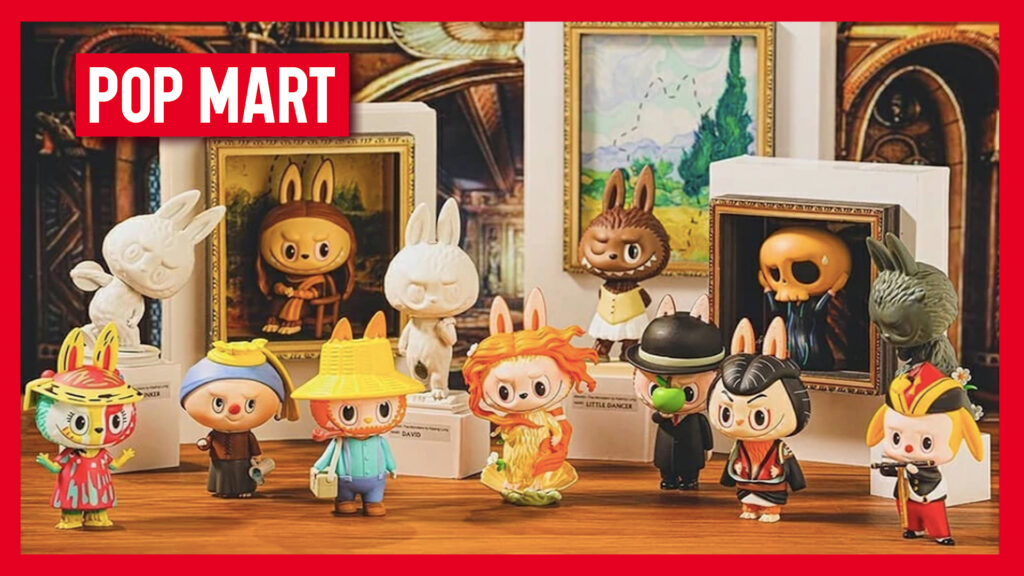The global IP toy industry is experiencing an unprecedented boom, with brands like Pop Mart’s Labubu, Sanrio’s Chiikawa, and countless other character-driven franchises capturing consumer attention and investor enthusiasm worldwide. This phenomenon represents more than just a passing trend—it signals a fundamental shift in how intellectual property (IP) intersects with consumer culture, retail strategy, and investment opportunities. The industry has evolved from simple licensed merchandise to sophisticated ecosystems where IPs drive multi-billion dollar valuations, influence stock markets, and reshape consumer behavior across generations.
This article will examine the current state of the IP toy business, analyze key market trends shaping its explosive growth, explore successful business models from Asia to the West, and identify 10 emerging IPs poised for international success in the coming years. From Pop Mart’s stock surge to the “blind box” economy and the rise of adult collectors, we’ll break down what makes this industry tick and where it’s headed next.

The Current State of the IP Toy Industry
The IP toy market has transformed into one of the most dynamic segments of the global entertainment and retail sectors. In 2024, the global IP toy market reached RMB 525.1 billion (approximately $72 billion), accounting for 37.4% of the entire IP derivatives market. This growth is being driven by several key factors:
1. Expanding Consumer Demographics: No longer just for children, IP toys now attract a massive adult collector base—the so-called “big kids” demographic. In mature markets like Japan and the U.S., adults have become the primary consumers of IP toys, with Japan’s adult demographic representing the majority of its toy market. This shift is now occurring in China and other Asian markets as well.
2. The Rise of Emotional Consumption: Modern consumers, especially younger generations, increasingly seek products that offer emotional fulfillment rather than just functional utility. IP toys satisfy this need by serving as physical manifestations of fandom, nostalgia, and personal identity. As noted in market reports, consumers value IP toys for their “unique cultural connotations and emotional resonance”.
3. The Blind Box Phenomenon: Pop Mart pioneered the blind box business model that has revolutionized the industry. These unmarked boxes containing random collectible figures create anticipation, scarcity, and a gamified purchasing experience. The model has proven so successful that Pop Mart’s Hong Kong-listed shares gained over 160% year-to-date in 2025 before recent regulatory concerns caused a pullback.
4. Cross-Industry Collaborations: IP licensing has moved beyond traditional toy manufacturing into fashion, food & beverage, tech accessories, and more. Successful examples include Realme’s smartphone collaboration with the Chinese anime “Perfect World,”美团’s “繁花” (Blossoms Shanghai) themed food promotions, and库迪咖啡’s (Cotti Coffee) high-profile partnership with “哪吒2” (Nezha 2).
Regional Market Breakdown:
- China: The fastest-growing major market, expanding from RMB 48.6 billion in 2020 to RMB 75.6 billion in 2024 (11.68% CAGR). Projected to reach RMB 91.1 billion in 2025. However, per capita spending remains low at RMB 53.6 compared to Japan’s RMB 244.7 and the U.S.’s RMB 387.0, indicating significant growth potential.
- Southeast Asia: The most explosive emerging market, growing at a 19.1% CAGR from 2020-2024 and projected to maintain 20% growth through 2029. Young demographics (over half under 35) and rising disposable incomes drive this expansion.
- North America: Still the largest regional market at 26.5% global share, but growth has slowed to about 3-5% annually.
- Japan: A mature market where IP toy strategies focus on deepening engagement with existing fans through premium collectibles and limited editions. Japanese companies like Bandai Namco (Gundam, Dragon Ball), Sanrio (Hello Kitty), and Tsuburaya (Ultraman) dominate global IP licensing.
Key Business Models Driving Success
Several innovative business approaches have emerged as winners in the IP toy space:
1. The Pop Mart Ecosystem: Pop Mart’s vertically integrated model—covering artist discovery, IP incubation, manufacturing, retail, and fan community building—has made it China’s top IP toy company with 11.5% market share. Its Labubu character, created by Hong Kong-Dutch artist Kasing Lung, became a global phenomenon, with a 4-foot-tall Labubu selling for $170,000 at auction in Beijing. Pop Mart’s “blind box” strategy creates artificial scarcity and collecting urgency, while its expansion into plush toys, apparel, and lifestyle products maximizes each IP’s monetization potential.
2. Japanese IP Licensing Powerhouses: Companies like Bandai Namco have perfected the “IP axis” strategy—developing multimedia franchises where toys, games, anime, and merchandise feed into each other. Bandai’s top three IPs (Dragon Ball, Gundam, and One Piece) generated RMB 17.04 billion in FY2025 alone. Sanrio’s China revenue surged 44% to RMB 816 million, with licensing accounting for 55% of that.
3. The Card Game Boom: Chinese company Card游 built an RMB 10 billion business primarily on奥特曼 (Ultraman) trading cards, selling 17.6 million cards in China during 2025. Similarly,布鲁可 (Bruok) generated RMB 1.096 billion from奥特曼 products, proving the viability of the collectible card model beyond traditional toys.
4. Hybrid Online-Offline Experiences: Successful players combine e-commerce with immersive physical retail. Bandai has opened高达基地 (Gundam Base) stores across China, while Sanrio operates 24 stores in China with frequent pop-up exhibitions. Pop Mart maintains 28 U.S. retail locations and 52 “Roboshop” vending machines alongside its digital sales channels.
5. Localized IP Development: International brands are increasingly creating market-specific IPs. Sanrio launched eight original Chinese characters like “雪球奈奈” (Snowball Nana) and “糯松松” (Sticky Song Song) to complement its global portfolio. This localization extends to product design—for example, Bandai collaborating with Shanghai intangible cultural heritage artisans to create Pac-Man themed traditional crafts.
Market Trends Shaping the Future
Several powerful trends are defining the industry’s trajectory:
1. From Short-Term Hype to Long-Term IP Management: Companies are shifting from one-off collaborations to building enduring IP ecosystems. As noted in analyses of the哪吒2 (Nezha 2) licensing boom, successful players now view IP partnerships as “not just short-term marketing, but part of long-term product operations”. The哪吒 franchise is projected to generate RMB 10-15 billion in merchandise sales alone.
2. The “Value Co-Creation” Model: Modern IP collaborations emphasize mutual brand enhancement rather than simple licensing. When美团 partnered with王家卫’s “繁花” (Blossoms Shanghai), they didn’t just slap logos on products—they created thematic dining experiences that elevated both brands. Similarly,泡泡玛特 (Pop Mart) worked closely with哪吒2’s creators to develop storyline-accurate blind boxes that deepened fan engagement.
3. Digital-Physical Convergence: AR/VR integration, NFC-enabled toys, and metaverse extensions are becoming standard. Lego’s “digital twin” concept and Bandai’s Tamagotchi smart toys exemplify this trend. Pop Mart is reportedly investing heavily in digital collectibles to complement its physical products.
4. The Secondary Market Boom: Rare collectibles now trade like blue-chip stocks. The aftermarket for Pop Mart’s secret Labubu figures (with 1 in 72 pull rates) sees prices reaching $500 for variants that retail at $30. Platforms like StockX and eBay have become essential to the ecosystem.
5. Regulatory Challenges: China’s recent scrutiny of blind box mechanics and secondary school trading card speculation signals potential headwinds. Companies must balance gacha-style monetization with responsible marketing, especially toward younger consumers.
6. Sustainability Pressures: EU regulations and consumer demand are pushing brands toward biodegradable materials and ethical production. Jellycat leads in eco-friendly plush toys, while Lego invests heavily in plant-based plastics.
10 Emerging IPs Poised for Breakout Success
Based on current trends and market signals, here are 10 IPs likely to make waves globally in the near future:
1. Chiikawa (ちいかわ)
- Origin: Sanrio’s newest superstar, a tiny, anxious creature that resonates with overworked millennials
- Why It’s Hot: China sales exploded during 2025’s 618 shopping festival; Sanrio is prioritizing it over legacy IPs
- Platforms:
- Official Site: https://www.sanrio.co.jp/characters/chiikawa/
- Instagram: @chiikawaofficial (1.2M followers)
2. Wacky Mart Series (Pop Mart)
- Origin: Pop Mart’s follow-up to Labubu featuring food-themed characters like Shrimp Tempura
- Why It’s Hot: Diehard collectors are flying between cities to secure limited editions; secondary market premiums exceed 300%
- Platforms:
- Pop Mart Global: https://www.popmartglobal.com/
- TikTok: @popmart.usshop (live drops every Thursday)
3. Omniga Ultraman (ウルトラマンオーミーガ)
- Origin: Tsuburaya’s new Ultraman series launching July 2025
- Why It’s Hot: Strategic partnership with Alibaba includes 500 new SKUs; targets Chinese tourist spending
- Platforms:
- Official Site: https://www.tsuburaya-prod.co.jp/
- Weibo: @Ultraman_Official (3.4M followers)
4. Snowball Nana (雪球奈奈)
- Origin: Sanrio’s first China-originated IP, a snow leopard girl
- Why It’s Hot: Part of Sanrio’s plan to grow China profits to RMB 500 million by 2028
- Platforms:
- Xiaohongshu: #雪球奈奈 (280K+ notes)
- Bilibili: Official animations coming 2026
5. Bear Lala Friends Club
- Origin: A Hong Kong-original teddy bear IP (launched in 2017) featuring a customizable bear with 20+ whimsical cross-play costumes, from dinosaurs to sharks
- Why It’s Hot:
- Combines stress-relief appeal (stretchy, squishy material) with collectible cosplay mechanics
- Expanding globally, already sold in 20+ countries with 4,475+ fans
- Actively seeking cross-industry collaborations (fashion, toys, gaming)
- Platforms:
- Official Site: http://www.bearlala.com
- Facebook: @BearLalaFriendsClub (Taiwanese market focus)
6. 52Hz Wagon Channel (奥迪x腾讯)
- Origin: Audi x Tencent’s content IP about niche car enthusiasts
- Why It’s Hot: Luxury brands tapping into China’s “little happiness” trend
- Platforms:
- WeChat Channel: 52Hz瓦罐频道
- Official collab site: https://www.audi.cn/52hz
7. Cloudy (云曦) from Perfect World (完美世界)
- Origin: Female lead from hit Chinese donghua (animation)
- Why It’s Hot: Realme’s “灵眸紫” phone collab sold out instantly
- Platforms:
- Bilibili: 《完美世界》official (8.9M subs)
- Taobao: 云曦周边 (official merch store)
8. Neo Tamagotchi (新拓麻歌子)
- Origin: Bandai’s 2025 reboot of the 90s classic with blockchain elements
- Why It’s Hot: Nostalgia + tech appeal; pre-orders exceeded 1M units
- Platforms:
- Official Site: https://tamagotchi.com/neo
- Discord: Tamagotchi Neo (180K members)
9. Dragon Blade (英雄无限)
- Origin: Bruok’s original Chinese mythology-themed IP
- Why It’s Hot: Taps into “国潮” (national trend) movement; educational angle
- Platforms:
- Douyin: @英雄无限 (2.1M followers)
- Official Site: https://www.bruok.com/yxwx
10. Pippo (from The Monsters)
- Origin: Labubu’s “brother” in Kasing Lung’s Monster Universe
- Why It’s Hot: Pop Mart is positioning it as their next global breakout after Labubu
- Platforms:
- Instagram: @pippo.themonster (new account)
- Pop Mart’s “Monster Tribe” collector app
Strategic Recommendations for Businesses
For companies looking to capitalize on the IP toy boom, several strategic approaches emerge from market leaders:
1. Build, Don’t Just License: While licensing established IPs provides short-term gains (as seen with Ultraman’s RMB 7.68 billion licensing revenue in China), developing proprietary IP creates lasting value. Pop Mart’s 53.2% revenue from original IPs like Molly and Labubu demonstrates this.
2. Master the Art of Scarcity: Limited editions, secret variants, and time-bound releases drive collector behavior. The 1 in 72 chase for rare Labubus creates a secondary market that fuels primary sales.
3. Think Beyond Toys: Successful IPs now span physical products, digital assets, experiences, and services. Sanrio’s China strategy includes animated content, theme restaurants, and art exhibitions alongside traditional merchandise.
4. Localize Authentically: Global IPs must adapt to regional tastes without losing core appeal. Bandai’s非遗 (intangible cultural heritage) collaborations in China show how to blend global IPs with local culture.
5. Leverage the Full Sales Funnel: From social media teasers to unboxing livestreams to collector forums, modern IP commerce requires an omnichannel approach. Pop Mart’s TikTok live drops generate frenzied buying moments.
6. Partner Strategically: Align with complementary brands for mutual uplift. The哪吒2 collaborations succeeded because each partner—from泡泡玛特 to库迪咖啡—enhanced the IP’s reach while strengthening their own brand positioning.
Challenges and Risks Ahead
Despite the industry’s rosy outlook, several challenges loom:
1. Market Saturation: With over 42谷店 (character goods store) chains competing in China alone, differentiation becomes difficult. In 2025, 104谷店 closed in China within six months due to homogenization.
2. IP Fatigue: Shortened IP lifecycles—some as brief as 3 months—force constant innovation. Maintaining long-term engagement is increasingly challenging.
3. Regulatory Uncertainty: China’s scrutiny of blind boxes and trading cards may spread to other markets. Responsible marketing practices will become essential.
4. Counterfeiting: The Lafufu phenomenon shows knockoffs can become competition rather than just copyright violations. Brands must decide whether to fight fakes or co-opt them.
5. Economic Sensitivity: While resilient, the industry isn’t recession-proof. During downturns, premium collectibles may struggle while affordable “little happiness” items thrive.
Conclusion: The Future of IP Commerce
The IP toy industry has matured from a licensing afterthought to a central pillar of global entertainment commerce. As Pop Mart’s valuation (despite recent corrections) and Bandai Namco’s record profits demonstrate, well-managed IP portfolios can generate outsized returns that dwarf traditional toy businesses.
Looking ahead, several developments will shape the next phase:
- AI-Personalization: Generative AI will enable mass-customized IP products, from unique character variants to personalized story integrations.
- Phygital Expansion: Blockchain-based digital collectibles will complement physical products, creating seamless “phygital” ownership experiences.
- Experience Economy: IP owners will shift from selling products to curating immersive experiences—a trend already visible in Sanrio’s exhibitions and Bandai’s VR Zones.
- Hyper-Localization: Global IPs will develop deeper regional variations to maintain relevance across diverse markets.
- Sustainability Integration: Eco-conscious IP positioning, like Jellycat’s material innovations, will become table stakes.
For investors and entrepreneurs, the message is clear: IP-driven commerce isn’t just growing—it’s fundamentally redefining consumer markets worldwide. The most successful players will be those who treat their IPs not as mere properties to license, but as living ecosystems that grow and evolve with their fan communities. As the Labubu phenomenon proves, in today’s market, a well-crafted character with the right business model can become not just a toy, but a global cultural icon.









